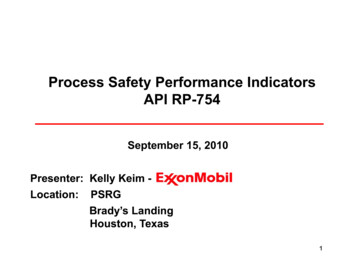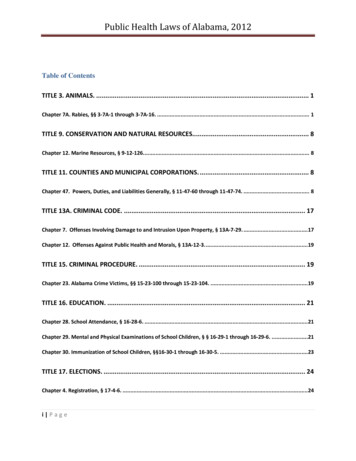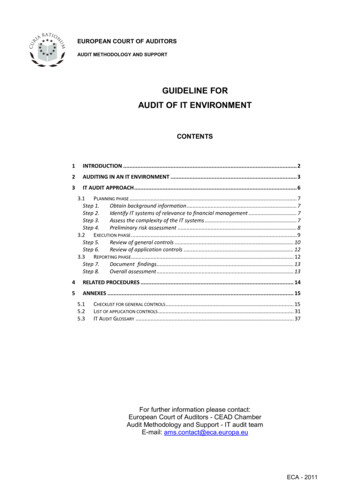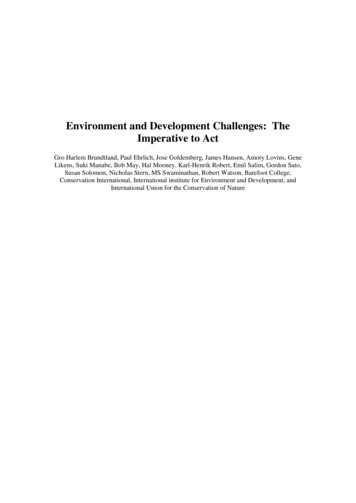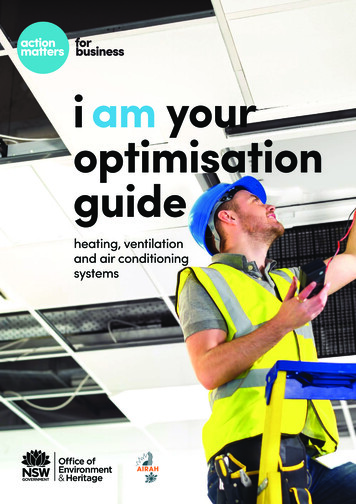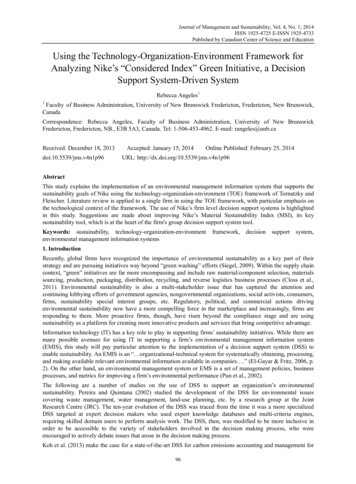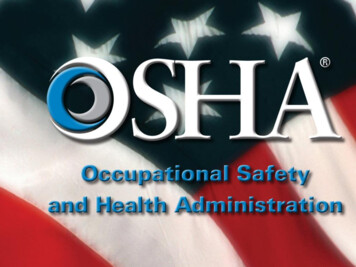
Transcription
2012 USW Health, Safety &Environment ConferenceOSHA’s Refinery & ChemicalNational Emphasis ProgramsThe Westin Convention Center PittsburghMarch 6, 2012Mike Marshall, PEPSM CoordinatorUSDOL-OSHA, Directorate of Enforcement Programs
National Emphasis Programs Provide for planned inspections in highhazard industries Focus efforts on specific hazards Refinery NEP focuses on implementation ofPSM in Refineries Chemical NEP focuses on implementationof PSM in all other PSM covered facilities
NEP PurposeTo control or eliminate workplace hazardsassociated with the release of highlyhazardous chemicals (HHCs)
Comparison of Refinery and ChemNEPs to Prior PSM Inspections NEPs are the most significant PSMenforcement actions since the standard waspromulgated in 1992 Significant differences between current effortand pre-2007 inspections:– 73% of early inspections were initiated due toaccidents, complaints or referrals.– Almost all Refinery NEPs were program planned
Comparison of Refinery and ChemNEPs to Prior PSM Inspections– NEP inspections have more violations and higherpenalties than prior PSM OR PQV inspections:Type of PSMInspectionProgramRefinery NEPChem NEPPQV and othernon-NEPinspections(Before 2007)Citations perInspectionPenalty ( ) perInspection11.28.42.376,80031,6002,950
Refinery NEP Originally launched June 7, 2007 Last inspections completed in 2011 Combined “static” and “dynamic” questionlists with guidance for compliance officers(CSHOs)
Refinery NEP Comprehensive Resource intensive for employers andOSHA– About 1,000 OSHA hours/inspection Compliance found to be highly unevenAverage penalties/inspection 76,821Average penalty/violation 6,859Average violations/inspection 11.2
Refinery NEP Frequently Cited cal Integrity19819.5%dProcess Safety Information17717.4%fOperating Procedures17417.1%eProcess Hazard Analysis16816.5%lManagement of Change929.0%mIncident Investigation686.7%hContractors444.3%oCompliance Audits414.0%gTraining292.9%nEmergency Planning & Response141.4%cEmployee Participation121.2%
Refinery NEP Frequently Cited 3)(ii)Compliance w/ RAGAGEP71119(j)(5)Correction of deficiencies63119(e)(5)PHA findings not addressed52119(l)(1)MOC not established/implemented39119(d)(3)(i)(B)P&IDs missing / incorrect37119(j)(2)No written MI procedures38119(e)(3)(v)PHA facility siting29119(f)(4)Safe work practices not established29119(j)(4)(iii)I&T frequency25119(j)(4)(i)Inspections and tests not performed24119(d)(3)(i)(D)Relief system design & design basis24119(f)(1)(i)(D)Emergency shutdown in OPs24
Lessons Learned Main Challenge – Refinery NEP hours 40times greater than average OSHA inspection– 1000 hours for REF NEP inspection– 25 hours for average OSHA inspection Learnings– List based approach does find hazards Compared to PQV approach– The listed questions also result in many “off-script” citations– CSHO training works– OSHA focus on RAGAGEP resulted in large number ofdeficiencies– 20 years after SHELL-Norco & Phillips-Pasadena,refining industry still has many problems with facility siting
Other Learnings from theRefinery NEP Citations in the NEP reflect the focus on PSI,Incident Investigation, and the various elementsinvolving RAGAGEP in Inspection Priority Items(IPI), and improved CSHO training Refineries are not resolving PHA and auditfindings and recommendations at a rateexpected of large, sophisticated employers
PSM-Covered Chemical FacilitiesANational Emphasis ProgramThe “Chem NEP”
Chem NEP Pilot Chem NEP effective July 27, 2009– Region I – CT, MA, ME, NH, RI– Region VII – Nebraska, Kansas, Missouri– Region X – Idaho Extended nationwide Nov. 29, 2011 Outlines a different approach for inspectingPSM-covered chemical facilities Not comprehensive Less resource-intensive
Chem NEP State plan participation is nowrequired– Can adopt Federal program or developone that is equally protective CSHO’s must check abatement ofPSM citations requiring abatementgoing back six years
Chem NEP ApproachDiffers from Refinery NEP– Intent is to perform a larger number of shorter,less resource intensive, inspections– A small number of “dynamic” list questionsare applied to a selected unit or units– No static list questions
Chem NEP Approach Questions are specific and contain complianceguidance (similar to Refinery NEP) Questions differ by type of facility– Ammonia refrigeration– General PSM (e.g., storage only)– Chemical Processing Dynamic questions are not published outsideOSHA Questions change periodically
Details Details of OSHA inspection procedures (FieldOperations Manual), as well as company andemployee rights and obligations, can befound on OSHA’s website The text of the Chem NEP (but not thedynamic list questions) is also accessible atwww.OSHA.gov
Chem NEP Inspections – November 2011(Completion of Pilot) 173 inspections have issued citations Average 8.4 citations per inspection with citations Average 31,587 in proposed penalties perinspection with citations19
Chem NEP Inspections – November 2011 60 standards cited: 5 major standards categories–––––1910 General Industry1904 Record Keeping5a1 General Duty1926 Construction1903 Inspections (abatement verification) 1,487 total proposed violations 5,464,553 total proposed penalties Overwhelming majority of violations under 1910 20General Industry ( 90%)
Top Twelve 1910 Standards ViolatedDescription#Cum %1910.119Process Safety Management89159.91910.147Lockout / Tagout5563.61910.120Haz Waste & Emergency Response4766.81910.134Respiratory Protection3669.21904.029Forms (Record Keeping)3171.31910.023Guarding Com1976.31910.146Permit Req’d Confined Space1977.51910.151Medical Services & First Aid1978.81910.212Machine Guarding1980.1General Duty1881.35a121
Chem NEP Inspections – Facility TypeUnprogrammed Inspections - 38% 2%Chlorine8%Contractor37%NH3 Refrigeration53%Other22
Chem NEP Inspections – Facility TypeTotal Inspections3%Chlorine9%Contractor41%NH3 Refrigeration47%Other23
Chem NEP Citations by PSM ElementElementDescription% of PSMCitationsCumulative %jMechanical Integrity23.2%23.2%dProcess Safety Information20.9%44.1%eProcess Hazard Analysis15.8%59.9%fOperating Procedures14.0%74.0%lManagement of Change5.5%79.5%oCompliance 1.1%cEmployee participation2.8%93.9%mIncident Investigation2.6%96.5%nEmergency Planning & Response1.8%98.3%iPre-startup Review1.1%99.4%24kHot Work0.6%100.0%
Chem NEP Citations by PSM ElementPareto hcmnik25
Chem NEP Citations by PSMSub-elementSub-element% All CitationsCumulative %PSI RAGAGEP7.0%7.0%119(j)(2)MI written procedures6.7%13.7%119(j)(5)MI equipment deficiencies3.7%17.4%119(l)(1)Management of Change dev & imp3.7%21.1%119(j)(4)(i)MI I&T performance3.6%24.7%119(e)(5)PHA findings & recommendations3.5%28.2%PSI P&IDs3.4%31.5%Compliance Audits performed / certified3.0%34.6%119(j)(4)(iii)MI I&T frequency2.7%37.3%119(e)(3)(i)PHA Hazards of the Process2.5%39.7%119(e)(1)PHAs performance2.2%42.0%119(f)(1)OP Developed & Implementation2.2%44.2%119(f)(3)OP annually certified2.2%46.5%26MI I&T follow (1)119(j)(4)(ii)Description
119(d)(3) 1(59()d)(3) (i)(B)119(o)(111)9(j)(4)(iii11)9(e)(3) (i)119(e)(1)119(f)(1)119(f)(3)119(j)(4)(ii)Chem NEP Citations by PSMSub-element (Pareto)8%7%5%4%3%1%0%60%50%6%40%30%20%2%10%0%27
VPP Sites and the NEPs VPP sites are not subject to programmedinspections However, the NEP applies OSHA-wide forunprogrammed PSM related inspections:– Accidents– Complaints– Referrals– Catastrophes
PSM .What’s Being CitedEXAMPLES1910.119 .
d(3) PSI Citations P&ID's not accurate Relief system design & design basis notdocumented Failure to document that equipment followsRAGAGEP– Relief device set at 540 psig for 480 psig MAWP(ASME B&PV Code)– Relief isolation valve positions not controlled (ASMEB&PV Code)– Relief valves undersized (API 521)– KO drum w/ inadequate retention time (API 752)– Trailers located subject to blast loading (API 753)– Positive pressure air supply to control building notalarmed (NFPA 496-2003 Section 7.4.7)
j(4) MI Inspect & Test Citations All aspects of j(4) cited Many types of equipment & controls. Many problems involved thicknessmeasurements Examples:– Process piping not inspected per facility’s I&Tprogram– I&T schedule on relief valves not adjusted whenvalves found to be heavily fouled– Cathodic protection system & process analyzers nottested per employers program requirements– Anomalous thickness measurements not resolved perRAGAGEP (e.g., API 570)– No inspection data for critical process piping circuit– Thickness readings not documented
f(1) Op Procedures Citations Many regarding procedures for emergencyshutdown, safe operating limits, operations w/oprocedures Examples:– Failure to address when emergency shutdown required &assignment to qualified operators– Operating limits – procedures not consistent w/instructions on DCS / control board– No procedures for operation of complex unit blowdownsystems– Lack of emergency OPs for flare system– No procedure for switching lube pumps on largecompressor
e(3) PHA Citations Not addressing siting or human factors; others fornot addressing consequences of failure ofcontrols, not identifying previous incidents Examples:– Siting - failure to address potential atmosphericblowdown impacts on shelters, furnaces, control rooms– Human Factors – failure to consider HF, failure toevaluate operator / DCS alarm interface, failure toconsider risk posed by unmarked equipment– Hazards – freeze protection of process piping– Hazards – lack of support steel fireproofing near likelyrelease points (pump seals)– Incidents – failure to consider previous incident withexplosive gas under UPS battery room
j(5) MI Deficiency Citations Wide variety of equipment operated outsideacceptable limits Examples:– Pipe or equipment thickness measurements belowretirement thickness– Intervening valves to/from relief valves not car sealedopen– Pressurized electrical cabinets w/o functional alarms– Broken flange bolts– Inoperable control panel board indicator lights– Inoperable valves (broken, non-functional, or fouled)– Gage glasses unusable– Toxic / LEL gas detectors in control room air supplynot working
j(2) MI Procedure Citations Procedures often lacking for special situations, andfor evaluating and resolving anomalous data Examples of missing or deficient procedures:– For under-insulation corrosion; for injection locations; forpressure vessels– For inspecting non-metallic linings in pressure vessels– Procedures did not address adequate number andlocations of TMLs– Relief valves past inspection intervals (many)– No procedures for performing repairs on pressure vessels(welder quals & certs, QC, etc.)– No procedure for resolving thickness measurementincreases (anomalous data)
e(5) PHA Recommendations Citations Mostly failure to resolve recommendations at all, orin a timely manner. Many recommendations requiring little investmentgo unresolved and unimplemented – “low hangingfruit”. Examples of unresolved findings/recommendations:– Relief isolation valves not car sealed open– 23 findings from 1996 PHA still unresolved– PHA recommendations “rolled over” from previous study,including instruments and alarms for detecting criticalequipment conditions– Recommendations on blast exposure of control roomsfrom multiple siting studies not resolved (periodically donew studies without resolving issues)– No written plans for implementing agreed actions
m(1) Incident Invest Citations Failure to investigate potentially catastrophicincidents (near-miss); frequently multiple instances Examples of failing to investigate–––––––––Pump seal failuresPacking blown out of pumpHC liquid and vapor releasesExchanger acid/HC leaks (alky units)CorrosionFCC fireOverpressure leading to release to flare systemPipe rack and line releasesInstrument leaks and failures
m(4) Incident Invest Citations Citations for all sub-elements. Failure to includeall required information is common.Contributing factors are often left out, or aretangential to the actual contributing factors Examples:– Date investigation began not listed– No determination of how cross-contaminationoccurred or was corrected– Causal factors not documented in 2 crude heatertube leak fires; in weld corrosion failure; in failure offaulty weld, in fan shaft breakage, in over-temperatureon a reactor, on smoke in a substation– Recommendations not established in crude heaterfire
l(1) MOC Citations Most frequently cited MOC was for failure to establish orimplement equipment design changes followed by operatingprocedure changes. Examples––––––––Removing secondary process piping wo/conducting MOCIncreasing charge to units wo/MOCChanging procedures for addition of methanol to chloride injection tankNo MOC for temporary weld patch for hole in pressure vessel3,600 barrel throughput change in unit wo/MOCAdded seven exchangers and associated piping to crude unit wo/MOCNo MOC for control room upgrade47 operating procedure changes and 58 alarm set point changeswo/MOC– No MOC for placement of temporary structures
o(4) Audit Citations Primarily failures to address deficiencies identifiedin compliance audits and document their correction Examples:– Problems with PSSR and MOC tracking and approvalnoted in last two compliance audits not resolved– Finding that OPs not being updated or unaddressed– Correction of deficiencies in maintenance program notdocumented– Audit findings from previous CA not addressed Ventilation system designs for control rooms Safety system information not available Testing & inspection frequencies not complying withRAGAGEP
QUESTIONS
OSHA’s DEP PSM Team Jim Lay– Lay.jim@dol.gov– 202-693-1827 Jeff Wanko– JWanko@dol.gov– 202-693-2137 Mike Marshall– Marshall.mike@dol.gov– 202-693-2179
times greater than average OSHA inspection . – 5a1 General Duty –1926 Construction –1903 Inspections (abatement verification) 1,487 total proposed violations 5,464,553 total proposed penalties . (NFPA 496-2003 Sec





